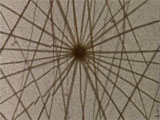On a clear day, Guy Maddin might be my favorite living film maker. He’s not to everyone’s taste (The Heart of the World, complete on YouTube, is a good litmus test), and I won’t attempt to convert the unbelievers. But anyone who would decide that Knut Hamsun’s Pan should be a Vaseline-lensed movie set on an ostrich farm inside the earth (Twilight of the Ice Nymphs) or who is making a movie about Raymond Roussel with John Ashbery can’t expect me to be rational and objective about what they do. Regardless of my sympathies, his work is formally interesting, and I think it bears scrutiny if we’re interested in how artistic forms change with technology.
While not entirely uncommercial, Maddin’s films set out to take filmmaking apart to its component pieces. Much of his work mines the aesthetic of the silent era of film making, particularly the German Expressionists, with grainy, high-contrast imagery, prominent use of intertitles, and grandly theatrical acting. Watching Maddin’s work reminds us that the form we know as the feature film is very much a constructed form, and we, as its audience have learned to read it. This is something we generally forget – the feature film has been around longer than just about anyone has been alive, and it’s as much a part of our mental furniture as the novel or the poem. But this wasn’t always so – in his autobiography, Luis Buñuel recalls watching early films in Spain:
In addition to the traditional piano player, each theatre in Saragossa was equipped with its explicador, or narrator, who stood next to the screen and ‘explained’ the action to the audience. ‘Count Hugo sees his wife go by on the arm of another man,’ he would declaim. ‘And now, ladies and gentlemen, you will see how he opens the drawer of his desk and takes out a revolver to assassinate his unfaithful wife!’
It’s hard to imagine today, but when the cinema was in its infancy, it was such a new and unusual narrative form that most spectators had difficulty understanding what was happening. Now we’re so used to film language, to the elements of montage, to both simultaneous and successive action, to flashbacks, that our comprehension is automatic; but in the early years, the public had a hard time deciphering this new pictorial grammar. They needed an explicador to guide them from scene to scene.
I’ll never forget, for example, everyone’s terror when we saw our first zoom. There on the screen was a head coming closer and closer, growing larger and larger. We simply couldn’t understand that the camera was moving nearer to the head, or that because of trick photography (as in Méliès’s films), the head only appeared to grow larger. All we saw was a head coming toward us, swelling hideously out of all proportion. Like Saint Thomas the Apostle, we believed in the reality of what we saw.
(My Last Sigh, trans. Abigail Israel, p. 32–33.) Maddin has resurrected this idea of the explicador in his most recent films, a loose biographical trilogy about his youth in Winnipeg – Cowards Bend the Knee (about, roughly: ice hockey; beauty parlors; abortion clinics: Sarah Palin avant la lettre); Brand Upon the Brain! (orphanages; young detectives; gender confusion); and My Winnipeg (sleepwalking; urban development; nostalgia). Brand Upon the Brain! is the most ambitious of the three: for the release of this film last year, Maddin mounted a theatrical production, where musicians provided a live soundtrack, foley artists reproduced the film’s sound effects, and an interlocutor narrated the film.
Watching the film this way is a disorienting experience: the audience sees the film and is drawn into the suspension of disbelief elicited by film. But between the audience and the screen are those creating the sounds that are part of the experience: while on the screen the audience sees a man going up the stairs, the audience can’t avoid seeing the foley artists who are making the noises of the man going up the stairs. The Russian Formalists would have called this estrangement.
Brand Upon the Brain! has just been released on DVD by Criterion; watching it in this form is a very different sort of experience. Of necessity, it’s a reduction of the richness of sensory experience of watching a live production. (Watching a movie on DVD rather than with an audience in a theater is always a different experience. In a theater, we are part of an audience and should behave in a certain way: generally, we don’t shout at the screen, or answer telephones in the midst of things, for example, because we are conscious that we’re part of an audience and have been socialized to behave properly.) One can’t fault Maddin or the Criterion Collection for this: movies are, of course, supposed to make money, not everyone could go to the live performances, and sometimes, Russian Formalists be damned, we don’t want to think about estrangement so much as we want to watch a movie.
But it’s still worth watching Brand Upon the Brain! on DVD. In a nod to the film’s original production, the DVD contains eight different soundtracks – three different narrators recorded in a studio, and five different narrators recorded in live performances in New York. The film thus viewed can be very different – as a sample, here’s a scene from near the beginning with three different narrators. First is the default choice, Guy Maddin recorded in a studio:
then John Ashbery, again recorded live:
then Isabella Rossellini, recorded live:
What the viewer sees is the same; but even though the narrators say the same things, what the viewer hears is very different. Maddin sounds bored and dismissive of his imagined biography; Ashbery sounds like your crazy uncle; Rossellini sounds like she’s been brought in from some wildly different film, possibly a European imagining of things are in Canada. It’s worth emphasizing that the music and sound effects in these three clips are different, as they’ve been recorded live in the Rossellini and Ashbery performances.
This DVD is an odd artifact: the film that it presents is in a sense indeterminate, presenting multiple possible films. It’s a trick that I’ve never seen exploited before, which is strange: multiple soundtracks for a film have been possible since the Laserdisc appeared thirty years ago. This particular aspect of the DVD is not new; it’s just something that it’s taken artists a long time to explore. It’s odd, really, that at a point in time when more movies are viewed on DVD than in theaters more films aren’t targeted as specifically to that viewing environment. It’s also striking to me how slowly technology changes. Criterion’s Brand Upon the Brain! could effectively have been released on Laserdisc: granted, DVDs are more convenient than Laserdiscs, but there’s nothing tremendously different in the possibilities for presentation. Blu-Ray, the designated successor to the DVD, promises a Java support, enabling more complex features, though no one seems particularly excited about a new physical format for movies, and I imagine that it will be years before anyone does anything interesting with this. Technology doesn’t wait for our ability to work constructively with it.












